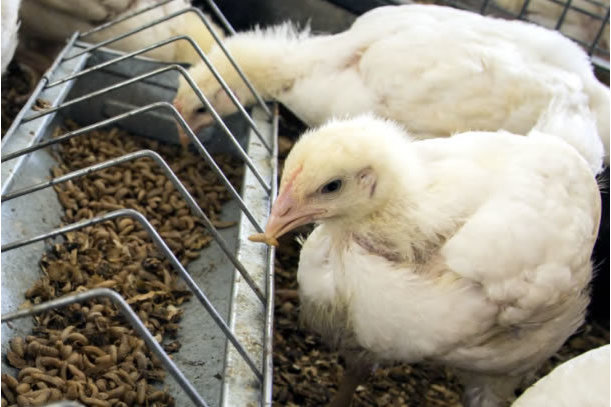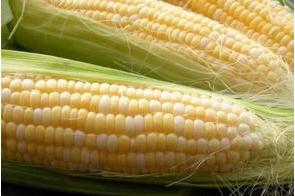Insects as sustainable sources of poultry feeds

Summary
Complementary feeding with insects and insect larvae is steadily solving the problem of high-production costs associated with raising farm animals.
Emma Naluyima, a private veterinarian and small-scale farmer in Uganda, operates an acre of farmland on which she has integrated crop and livestock farming. On her one-acre farmland, Emma raises pigs on one quarter of the farm and cattle on the second quarter. She grows cooking banana (popularly called matoke, a staple food in Uganda) on the third quarter and fish, fodder for animals and vegetables and fruits on the fourth quarter. She says she has been able to reduce her cost of fish and chicken production by about seventy to eighty percent by replacing fish and chicken meals with maggots and earthworms.
On the quarter of the piece of land where she grows pigs, Emma breeds maggots and earthworms from pig dung. She feeds her chickens with these maggots and in four weeks, she can produce chickens weighing 1.5 kilogramme (kg) each. Using commercial feed, she produces chickens weighing 1 kg in the same period. Interestingly, Emma makes millions of Ugandan shillings from her one-acre farmland.
Smallholder farmers continue to dominate agriculture in many countries across Africa and Asia. According to the Food and Agriculture Organisation of the United Nations (FAO), eighty percent of farmlands in sub-Saharan Africa and Asia are managed by smallholder farmers who work on land areas ranging from one hectare to a maximum of ten hectares. Majority of these farmers farm on just a few plots to feed their households and most of them are very poor. 1.5 billion people, out of the 2.5 billion in poor countries whose livelihood is in the agriculture sector, are smallholders.
In many parts of Africa, most of the young people who go into farming do so probably after failed attempts to secure their desired jobs. Others go into farming to supplement their income from low-paying jobs. Many young people cannot afford to purchase large plantations or hectares of land.
In East Africa, for example, farmlands are often inherited from parents and shared among the children. A child who may have received a few acres from his parents will someday have to share this piece of land among his own children before his death. Depending on the number of children in a family, the piece of land available to subsequent generations in the family keeps reducing. An individual may end up with as little as a plot or at most, an acre. This method of land ownership contributes to the increasing number of smallholder farmers in the region.
But smallholder farmers can be very productive. The challenge, especially for livestock and poultry farmers, is often the cost of feeding these animals. Poultry birds require adequate nutrients to grow as broilers for meat production or layers for egg production. Feed requirements differ slightly for broilers and layers. But they both require protein and energy sources, as well as minerals and vitamins.
These feeds, especially protein sources – fish, soybean and meat, can be quite expensive. And in addition to the cost of drugs and immunization, many poultry farmers hardly make profit. It is not surprising why most small-scale farmers, especially the 'plan B' farmers, don't usually go for livestock or poultry farming. To encourage more farmers to go into poultry, livestock and fish farming, there is need for cheap alternative sources of protein.
According to Emma, the biggest and most expensive feed requirement for her chickens is protein. The maggots and earthworms help her solve this problem. In four to five days after allowing houseflies to lay eggs on the pig dung, juicy maggots emerge for her chickens to feed on.
Poultry birds generally enjoy feeding on insects, especially those on pasture. On a dry mass basis, protein is a major component of insects with values ranging from 21 percent to 80 percent of the dry mass. A number of field trials with different insects such as grasshoppers, crickets, aphids and so on have shown that the quality of insect protein is similar to that of soybean meal or fish meal.
Another content of fresh insects is moisture. Moisture content ranges between 55 percent and 85 percent of the dry mass. And insects with low moisture content are known to be high in fat. Fat content of insects varies from 2 percent to 60 percent.
Because of the expansion of poultry industry in developing countries in recent times, insects are now reared on commercial basis to formulate feeds for poultry birds.
Cockroaches, grasshoppers, crickets, lice, beetles, caterpillars, flies, wasps and ants have all been used to complement poultry feed. Termites have also been used as feed for chickens and guinea fowls in Togo and Burkina Faso for decades.
In fact, a study by a group of researchers from the International Centre for Tibetan Plateau Eco-system Management and College of Pastoral Agricultural Science and Technology, Lanzhou University in China, shows that the meat of free-range broilers fed on grasshoppers had more antioxidative potentials and longer storage life when compared to the control group fed with basal diet (commercial feed).
To be sure, insects have a protein-rich exoskeleton. But their mineral content is relatively low; hence the need to supplement with calcium when feeding with insects and worms. However, apart from protein content, feeding chickens and other poultry birds with insects have other benefits. For example, chitin, a polysaccharide (complex carbohydrate) found in the exoskeleton of insects may help to boost the immune system of poultry birds, thereby, reducing the need for antibiotics.
Unlike insects, worms such as maggots (the larva of the common housefly) and earthworms are easier to produce in very large numbers from dung or other organic wastes, including animal slurry in a short period of time. We often see chickens pick out worms and larva from topsoil. So, feeding on worms is very natural for poultry birds.
Maggots have a dry matter of 30 percent and about 54 percent crude protein. They can be eaten fresh or as dry products for ease of storage and transport. Local poultry farms, especially smallholder farms, can rely on maggots for protein source.
Some studies have also revealed that replacing 15 to 25 percent of fish meal with maggot meal in poultry diet can improve growth performance and meat quality of broilers. Other worms that have been used as protein source are silk worms and meal worms, which like maggots can be produced on low-nutrient organic wastes.
Growing maggots from animal dung is sustainable and environmentally useful. As houseflies feed on animal dung and decompose it, they lay eggs, which hatch into maggots and the maggots also feed on the dung. This helps to convert the unpleasant livestock waste into useful materials (maggots).
Emma mentioned to me that she plays around the life-cycle of the housefly to make sure that maggots are available daily. “We only need to add calcium supplements because maggots do not contain calcium. If grains are needed, just a little will do,” she added.
I must say that houseflies are not the only flies capable of producing maggots. Black soldier flies also do. One black soldier fly can produce 500 to 1500 maggots in four to five days. Also, a dried black soldier fly's pupa contains up to 42 percent protein and 35 percent fat. They have been demonstrated to support excellent growth in chicks, pigs, catfish and tilapia.
In most parts of the world, the use of insects in feeding fish is not well appreciated. Only 5 percent of farmers in Uganda, for example, use termites to feed fish. For Emma, after collecting maggots from her pig dung, she introduces earthworms, which feed on the dung and reproduce. And that is what her fish feed on.
Although the opportunities that insects can create for poultry and aquaculture are yet to be fully harnessed, there is another untapped opportunity in insect farming. This involves raising insects in a designated area, that is, a farm, and controlling the factors required for their growth such as diet and food quality and living conditions.
Insects reared under this condition could be processed for commercial purposes. Selling them to organic poultry farmers as complementary feed or to the pet-food industry could create some job opportunities for young people. For example, meal worm and crickets are primarily reared as pet food in North America, Europe and parts of Asia. Rearing insects for this purpose can be encouraged in sub-Saharan Africa, too.
To increase meat production by as much as 70 percent to feed the world by 2050, farmers must make do with innovative approaches to rear livestock, poultry birds and fish. Complementary feeding with insects and insect larvae is steadily solving the problem of high-production costs associated with raising farm animals. It is also more economically profitable than using commercial feed.
Financial Nigeria Columnist, Mojisola Ojebode, is a Nigerian biochemist and the founder and product developer at Moepelorse Bio Resources, is a Global Innovation Through Science and Technology (GIST) awardee, and an Aspen New Voices fellow.
Related
-
Redirecting agricultural subsidies for a sustainable food future
Public agricultural funding should focus on mitigation and synergies between reducing emissions and producing more food.
-
Africa makes progress on reducing food losses – new SDG report
Post-harvest losses in sub-Saharan Africa are estimated at about $4 billion per year.
-
How to create wealth through agriculture in Africa
While both the employed and the unemployed across Africa have been encouraged to engage in agriculture, the focus has been ...







